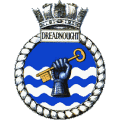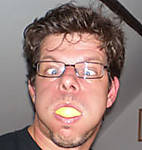JULY 08
Ok, here is the July blog! The theme for this month is “Oops!” due to the many, well, “oops!” I encountered this month.
We re-start with the hull; last month I had glued both halves with Tenax being a tad surprised at the somewhat bad fit. Now is time to fix the seam!
For this procedure, I will use a method taken from the aircraft world, used by many to ensure good fuselage seams; the method is found
here Mark off the seam with masking tape in order to minimize sanding and protect any surface details around the seam

Apply putty, I use Squadron white

I then smooth over the putty with a Q tip dabbed in acetone-containing nail polish remover (Cutex). This also decreases amount of sanding; I move the Q tip perpendicular to the seam as to not remove the putty actually filling the seam!

Let dry for a day, remove the tape and you have your putty-seam.

Carefully shave off excess putty with Xcto blade

And start the sanding process.. I used squadron sanding files, Med – Fine – Xfine progression.

The next step is to determine if the seam is actually, well, seamless! Usually, you would spray a light mist of primer in order to highlight any seam flaws. I decide instead to experiment with using a testors’ enamel marker in order to save time. Here are the results:

You DO save the time (and AB cleaning) but the enamel paint lies in too thick and dark (Oops #1). Sometimes it is hard to see any seam flaws due to the “streaky” way the paint flows from the applicator. In any case, you can see some sections of the seam that are flawed (middle of the picture)

I had to go back over those areas with more putty, this time “cut” with Cutex in order to make a paste, fill in the problem areas, dry, sand, etc. After all of that, I sanded the hull with 1000 & 2000 grits sandpaper to try and get rid of the many hull scratches.
NEXT assembly step was the gluing of the shaft parts to the hull. Oops #2! I made the rookie mistake of NOT dry-fitting the shaft assembly to the hull, resulting in major (1-2mm) gaps on the sides of some of the struts. I should have carefully sanded a “contour” to the struts so they would fit the curvature of the hull. Oh well! Ok, so putty to the rescue…. I tried to use Tamiya Liquid primer, viscous filler that can be used as putty. Oops #3! The stuff may work for small gaps, but it is VERY hard to apply at a specific location without spillage to surrounding areas. Moreover, it contracts when it dries, leading to the need for multiple coats. I had to sand the whole mess away (no pics of the mess!) and start again. I used the aforementioned Squadron white “cut” with Cutex to make a paste. Once dried, I carefully shaved the excess and sanded around the areas:


If anyone has a better suggestion besides of what I just did, please let me know! : )
At least the back did not give me any trouble…
Onwards to the boat!
Last month I painted the black and red portions on the hull. First step was to fix couple nasty sink holes on deck, using the Tamiya Surface primer

I had to re-apply THREE times due to the shrinkage I alluded to above… next time I will try the Mr Surfacer line of products. Anyways, I painted grey deck and the cabin white as per instructions. I am using MM enamel #1723, Gunship Gray (FS36008) as “Deck Gray”.

I still need to (carefully) paint the windows (I will use semi-gloss black) and the life preserver.
The 20mm Phalanx CWIS assemblies, the ammo canister painted white as per instructions. The rest of the assembly has not been painted yet (needs Haze gray).

The other part of the ship calling for ‘white” paint was the missiles… but white missiles denote active/live birds, so I was thinking of painting them BLUE instead (training/duds) missiles.
Final step was putting together the Mk45 5” guns… or, Oops #4! The cannon had a nasty seam that was a pain to shave. I was then in the course of dry-fitting the assembly together and “clamping” it down for gluing, when the whole thing went flying… I was not able to recover/find one of the cannons…so I guess I need to ask the judges for a temporary “scratchbuilding” license to (attempt to) make a substitute out of spare sprue material. The good news is that the floor surrounding my workbench is very clean now since I swept the area three times.

And that is where we stand! Next is priming the hull; after fixing any flaws, then anti-fouling red paint. Also continue to work on the subassemblies: the boat, the weapon systems. The next big step (probably in 2 months) will be to start the deck assemblies.
Thanks for looking; any comments or suggestions are welcome! Cheers all



























































































 cheers!
cheers!
























 . You can try using Gator's applicators for his Gator glue, MAYBE it will work if the applicator does not have a rubber pad, which of course is not an issue with dealing with water based glues! Finally, if you feel "cold" in your finger when you are holding the parts together, drop them immediately! Not because the glue will stick yoru skin to the plastic a la CA glue, but because the glue will melt the plastic and make a nice impression of your fingerprints on the plastic! Again, talking from first hand experience
. You can try using Gator's applicators for his Gator glue, MAYBE it will work if the applicator does not have a rubber pad, which of course is not an issue with dealing with water based glues! Finally, if you feel "cold" in your finger when you are holding the parts together, drop them immediately! Not because the glue will stick yoru skin to the plastic a la CA glue, but because the glue will melt the plastic and make a nice impression of your fingerprints on the plastic! Again, talking from first hand experience 
















